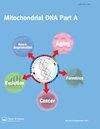Molecular phylogenetic study on few morphotypes of a patellogastropod Cellana karachiensis from northern Arabian Sea reveals unexpected genetic diversity
IF 0.6
4区 生物学
Q4 GENETICS & HEREDITY
引用次数: 3
Abstract
Abstract A group of limpets, Cellana karachiensis, exhibiting phenotypic plasticity were examined from Gujarat coastline India, using molecular phylogeny. Previous examination of the COI genes established the presence of three different haplotypes X, Y and Z, while present study showed three more haplotypes X1, X2 and Z1. Thus, a total of six COI gene haplotypes, having 99.23% to 99.85% sequence similarity, were observed with variations at six sites. Bayesian phylogenetic analysis shows divergence of lineages X–Y, X1–X2 and Z–Z1. Careful observation of nucleotide alterations showed a nonrandom mutation with more A↔G and C↔T transitions between closely related species of the genus Cellana. A stretch of 17 base pair, within COI region, was marked as region with high degree of variability between species of Cellana. Results suggest that this could be the beginning of speciation, with partial or complete reproductive barrier or these are already distinct species in different stages of evolution.阿拉伯海北部扇形足类Cellana karachiensis几种形态的分子系统发育研究揭示了意想不到的遗传多样性
摘要利用分子系统发育研究了印度古吉拉特邦沿海地区一群具有表型可塑性的帽贝(Cellana karachiensis)。先前对COI基因的检测确定了三种不同的单倍型X、Y和Z,而本研究发现了另外三种单倍型X1、X2和Z1。因此,共观察到6个COI基因单倍型,序列相似性为99.23% ~ 99.85%,6个位点存在变异。贝叶斯系统发育分析显示谱系X-Y、X1-X2和Z-Z1存在分化。对核苷酸变化的仔细观察表明,在密切相关的草属植物之间存在一种非随机突变,有更多的a↔G和C↔T过渡。在COI区域内,有17个碱基对被标记为Cellana种间高度变异的区域。结果表明,这可能是物种形成的开始,具有部分或完全的生殖障碍,或者它们已经是处于不同进化阶段的不同物种。
本文章由计算机程序翻译,如有差异,请以英文原文为准。
求助全文
约1分钟内获得全文
求助全文
来源期刊

Mitochondrial Dna Part a
Biochemistry, Genetics and Molecular Biology-Genetics
CiteScore
3.00
自引率
0.00%
发文量
6
期刊介绍:
Mitochondrial DNA Part A publishes original high-quality manuscripts on physical, chemical, and biochemical aspects of mtDNA and proteins involved in mtDNA metabolism, and/or interactions. Manuscripts on cytosolic and extracellular mtDNA, and on dysfunction caused by alterations in mtDNA integrity as well as methodological papers detailing novel approaches for mtDNA manipulation in vitro and in vivo are welcome. Descriptive papers on DNA sequences from mitochondrial genomes, and also analytical papers in the areas of population genetics, phylogenetics and human evolution that use mitochondrial DNA as a source of evidence for studies will be considered for publication. The Journal also considers manuscripts that examine population genetic and systematic theory that specifically address the use of mitochondrial DNA sequences, as well as papers that discuss the utility of mitochondrial DNA information in medical studies and in human evolutionary biology.
 求助内容:
求助内容: 应助结果提醒方式:
应助结果提醒方式:


